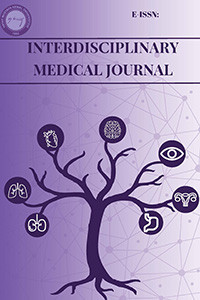Evaluation of notifiable infectious diseases between 2018 and 2021 in Van province: A descriptive study
Evaluation of notifiable infectious diseases between 2018 and 2021 in Van province: A descriptive study
Notification Infectious Disease, Surveillance,
___
- Tulchinsky T, Varavikova E. Bulaşıcı Hastalıklar. In: Vaizoğlu S (eds). Yeni Halk Sağlığı. 3. Baskı. Ankara: Palme Yayınevi; 2019. pp. 149–233.
- Gibbons CL, Mangen M-JJ, Plass D, Havelaar AH, Brooke RJ, Kramarz P, et al. Measuring underreporting and under-ascertainment in infectious disease datasets: a comparison of methods. BMC Public Health. 2014;14(1):147. https://doi.org/10.1186/1471-2458-14-147.
- Swaan C, van den Broek A, Kretzschmar M, Richardus JH. Timeliness of notification systems for infectious diseases: A systematic literature review. PLoS One. 2018;13(6):e0198845. https://doi.org/10.1371/journal.pone.0198845.
- Keramarou M, Evans MR. Completeness of infectious disease notification in the United Kingdom: A systematic review. J Infect. 2012;64(6):555–64. https://doi.org/10.1016/j.jinf.2012.03.005.
- Keskinler ÜD. The Evaluation of Obligatory Notificable Diseases Reported In Provincial Health Directorate In Erzurum. Journal of Turgut Ozal Medical Center. 2003;10(2):77–81.
- Public Health Law. 06.05.1930; Number: 1489 [Internet]. [cited 2022 Apr 21]. Available from: https://www.resmigazete.gov.tr/arsiv/1489.pdf.
- Communique on the Notification System of Infectious Diseases. 06.11.2004; Number: 25635 [Internet]. [cited 2022 Apr 12]. Available from: https://www.mevzuat.gov.tr/atNo=8580&MevzuatTur=9&MevzuatTertip=5.
- Notification System of Infectious Diseases. Circular 2015/18 [Internet]. [cited 2022 Apr 12]. Available from: https://hsgm.saglik.gov.tr/dosya/mevzuat/genelge/2015_18.pdf.
- Wurtz R, Cameron BJ. Electronic Laboratory Reporting for the Infectious Diseases Physician and Clinical Microbiologist. Clin Infect Dis. 2005;40(11):1638–43. https://doi.org/10.1086/429904.
- Turkish Statistical Institute (TÜİK). [cited 2022 Apr 12]. Available from: https://data.tuik.gov.tr/Kategori/GetKategori?p=Nufus-ve-Demografi-109.
- İbrhim İE, Uçku R. Assessment of Communicable Disease Notification in a University Hospital, 2005-2008. DEÜ Tıp Fakültesi Derg. 2012;26(1):1–7.
- Kıymet E, Böncüoğlu E, Çağlar İ, Zora F, Apa H, Bayram N, et al. Evaluation of Infectious Diseases Surveillance Data in 2018 in Dr. Behcet Uz Children’s Hospital. J Dr Behcet Uz Child s Hosp. 2019;9(3):223-228. https://doi.org/10.5222/buchd.2019.13471.
- Geng M-J, Zhang H-Y, Yu L-J, Lv C-L, Wang T, Che T-L, et al. Changes in notifiable infectious disease incidence in China during the COVID-19 pandemic. Nat Commun. 2021;12(1):6923. https://doi.org/10.1038/s41467-021-27292-7.
- Adegbija O, Walker J, Smoll N, Khan A, Graham J, Khandaker G. Notifiable diseases after implementation of COVID-19 public health prevention measures in Central Queensland, Australia. Commun Dis Intell. 2021;45.
- Neiderud C-J. How urbanization affects the epidemiology of emerging infectious diseases. Infect Ecol Epidemiol. 2015;5(1):27060. https://doi.org/10.3402/iee.v5.27060.
- Connolly C, Keil R, Ali SH. Extended urbanisation and the spatialities of infectious disease: Demographic change, infrastructure and governance. Urban Stud. 2021;58(2):245–63. https://doi.org/10.1177/0042098020910873.
- Yayın Aralığı: Yılda 3 Sayı
- Başlangıç: 2023
- Yayıncı: Hatay Mustafa Kemal Üniversitesi Tıp Fakültesi Dekanlığı
Mehmet Cenk BELİBAĞLI, Nilüfer AYGÜN BİLECİK
Breast cancer and the molecular mechanism of estrogen signaling
Yalçın ERZURUMLU, Hatice Kübra DOĞAN
Evaluation of serum adipocytokine and interleukin-18 levels in patients with epilepsy
Ahmet DÜNDAR, Derya KILINÇ, Ahmet YILMAZ, Vugar JAFAR, Orhan AYAN, Mehmet Uğur ÇEVİK, Hamza ASLANHAN
Ömer Faruk TEKİN, Müberra ÇAKICI TOSUN
Monocyte eosinophil ratio and red blood cell distribution width in the diagnosis of asthma
The effect of Covid-19 anxiety on prenatal distress and prenatal attachment in pregnant women
Dilay KARADEMİR, Ezgi AĞADAYI, Seher KARAHAN
Hacer DEMİRKÖSE, Furkan AKYÜZ, Mehmet Enes GÖKLER
Hatice Mine ÇAKMAK, Kenan KOCABAY
The role of surgery in perianal disease developing in hematology malignancy patients
Serkan ERKAN, Ramazan GÜNDOĞDU, Murat KUŞ, Hakan YABANOĞLU
Özlem NALBANTOĞLU, Semra GÜRSOY, Tarık KIRKGÖZ, Filiz HAZAN, Behzat ÖZKAN
